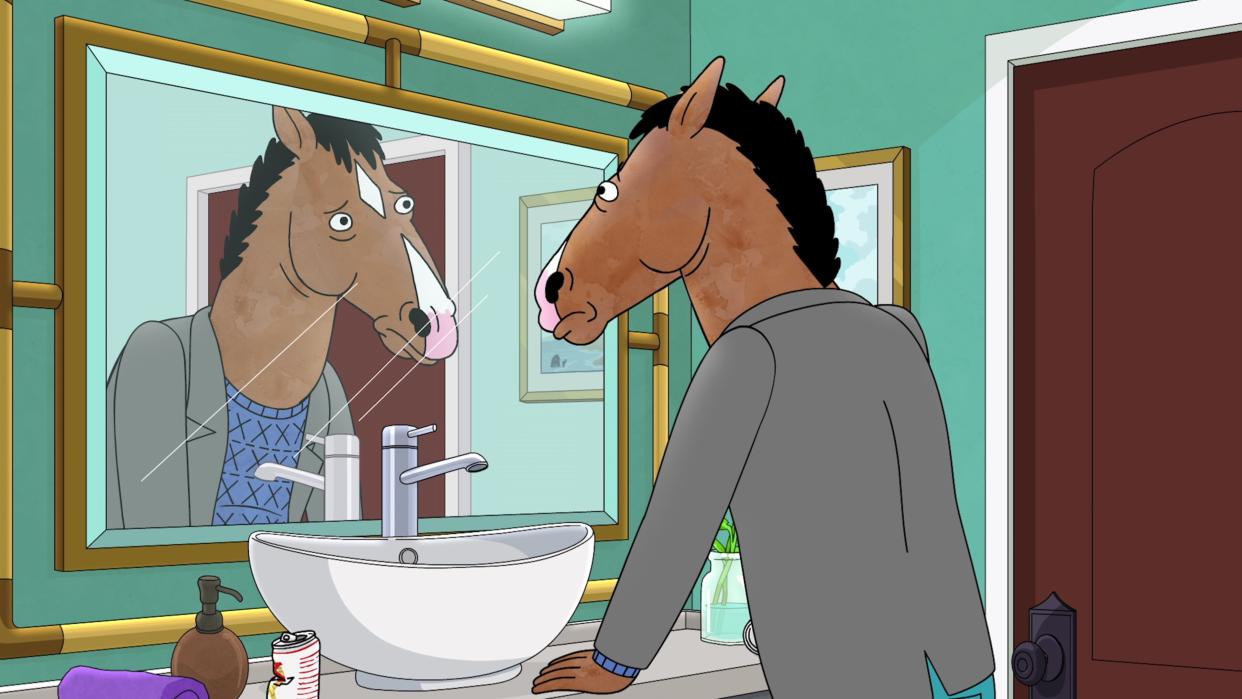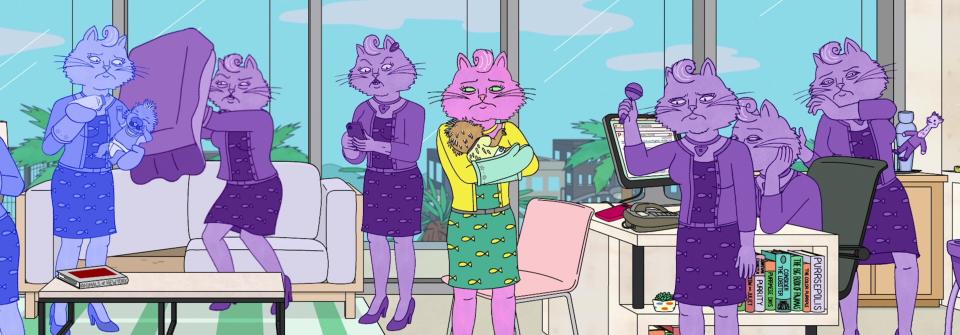What To Watch On Netflix That’s New This Week (Oct. 20-26)

The Netflix Highlight: “BoJack Horseman,” Season 6, Part 1
What’s up: Netflix’s “BoJack Horseman” is an animated comedy entering its final season. This sixth season focuses on BoJack Horseman, a wealthy, alcoholic, former sitcom star finally trying to change and find forgiveness. The character lives in “Hollwoo” (he stole the “D” from the Hollywood sign as a romantic gesture in Season 1), Los Angeles and the animated world includes both humans and anthropomorphized animals. BoJack Horseman is, well, a horse-man. Netflix broke the final season into two parts ― the second half will debut on Jan. 31, 2020.
This season begins with a shot of the cosmos (imagery that recurs throughout the next few episodes and ultimately becomes important to the narrative). After focusing on the stars, the show has a flashback to the night that BoJack’s former co-star and somewhat mentee dies after the two go on a bender together. BoJack calls out her name, “Sarah Lynn,” twice in voiceover. Eventually, BoJack drives in his bottle-filled car with broken windows to the hospital and speaks with Lynn’s family. He also talks to a cop, who has no interest in hearing BoJack’s confession. BoJack returns to his car, opens the door, and bottles spill out. He picks up a bottle of fernet, opens it, and in a silhouette against the cosmos, this shadow of a black horse figure chugs and chugs.
The main voice cast includes Will Arnett, Alison Brie, Aaron Paul, Amy Sedaris and Paul F. Tompkins.
The first half of this sixth and final season runs eight episodes of roughly 25 minutes each.
Sum-up: In these final episodes, the show teases that the cast of depressed characters may finally be figuring out a thing or two internally, even as the world around them gets bleaker than ever. Gone is the early premise of having sad characters frustrated that they’re sad in sunny, cheery Los Angeles. Now, most surrounding characters have gotten on the same page that contemporary American life brings daily horrors of systemic inequalities, unchecked capitalism and political malfeasance (the show doesn’t mention President Donald Trump, but does imply his presence). The only path to happiness will be making the best out of bad, or at least, suboptimal situations.
Even after all these years, “BoJack Horseman” continues to experiment with new forms of storytelling ― such as inventive use of animation to illustrate the daily juggling the Princess Caroline character has to do to balance her career with motherhood. Throughout a Princess Caroline-centric episode, the character passes through the world with multiple shadow-clones of herself completing (and failing to complete) other tasks at the same time. This ultimately leads to burnout and the incredible need for a cat nap (the character is a cat-person).
Along with the darkness, the show still packs in the pun and reference-heavy jokes that it has used in past seasons. Early in this season, these jokes culminate in an ambitious scene that has the characters BoJack, Diane, Todd, Princess Caroline and Mister Peanutbutter on a five-way phone call. Mister Peanutbutter describes an apocalyptic mess he has created with a drone (while standing in the remnants of this mess) with tons of references, such as former VJ Downton Julie Brown and Beethoven’s Fifth Symphony. Princess Caroline responds in an impressive tongue-twister that ropes together all the details of Peanutbutter’s long-winded story:
Wait. You’re telling me your dumb drone downed a tower and drowned Downtown Julie Brown’s dummy drumming dum-dum dum-dum, dousing her newly found, goose down, hand-me-down gown?
This season is full of magical moments like this that break up the inescapable doom.
Heads up: By this Season 6, the writers have figured out the engine of the show and deftly balance drama with comedy, darkness with light, and showy hijinks with internal reckonings. I don’t have major issues to point out, so I’m just going to nitpick about an episode set in my home of Chicago. The writers repeatedly get certain details about the city wrong that seem to come from Los Angeles-based staffers just Googling city details. To get extremely nitpicky, the show has an outdoor scene on the platform of the CTA blue line at the Clark/Lake stop. The CTA blue line at the Clark/Lake stop is indoors! So egregious. I do need to praise an extremely solid Chicago-based joke on the anthropomorphic animal concept ― instead of the Chicago Cubs, the baseball team is the Chicago Baby Humans. I also appreciated a bull person wearing a Michael Jordan Bulls jersey and a polar bear person wearing a Brian Urlacher Bears jersey.
Close-up: A scene early in the season showcases the rich blending of plot with background jokes made possible by this stylized world. While BoJack struggles to not drink at a mansion party, he encounters a mosquito woman making out with a man, causing itchy mosquito bites to appear on the man’s face. Behind this make-out duo, what appears to be an authentic Frida Koala (instead of Frida Kahlo) self-portrait hangs on the wall of the mansion.
In the next scene, as BoJack has a fairly serious talk with another character in the foreground, two women in “Spring Breakers”-esque outfits of bright-colored clothing and ski masks steal the Frida Koala painting in the background. Even more subtle, these thieves wear Groucho Marx mustache-glasses over their ski masks to further disguise themselves. Packing all these jokes into the frame gives the viewer so many reasons to pay attention, which ultimately helps carry the darker, more emotional narrative arc of BoJack’s internal reckoning. Also, this is only semi-relevant, but at another point in the season, a Vincent van Goat portrait hangs in BoJack’s rehab center.

History: The “Pastiches” Malibu rehab center that BoJack checks in to seems to be based on Passages Malibu and Promises Malibu. I won’t get into the list of celebrities who have attended these places, but here is a description of how the now-defunct Promises started, from The New York Times:
Blame the Malibu Model for it all. Fifteen years ago, Richard Rogg, a real estate developer who turned to treating substance abuse after kicking a cocaine habit, opened Malibu’s first drug and alcohol rehabilitation center. From the beginning, Promises Malibu, originally housed in two rambling Mediterranean-style residences in the Big Rock area, was meant to serve as an alternative to hard-line traditional programs. Promises offered customized care — drawing on psychotherapy and holistic practices like yoga, meditation, and biofeedback — in vacationland surroundings. Mr. Rogg registered Malibu Model as a service mark for his treatment plan.
Comparable shows: “BoJack Horseman” has the most similarities with fellow Netflix Original “Tuca & Bertie” for obvious reasons ― the latter’s creator Lisa Hanawalt also designs and produces “BoJack.” Both shows utilize the animated medium to feature a maximalist setting of rich details with hidden background jokes. A nonanimated precursor to this background humor is another Arnett show (and now Netflix Original) “Arrested Development,” which gained much notoriety for hiding comedic Easter eggs in scenes. And an additional animated contemporary would be “Rick & Morty,” which similarly wades into the existential calamities of perpetual depression by sending its protagonists on quests (though its journeys involve time and space travel, while BoJack quests take place in “Hollywoo”).
The characters and money: BoJack has to pay $100,000 to stay at Pastiches rehab in Malibu. When told the price, he balks and wonders aloud whether the room comes with a complimentary $90,000. Still, BoJack seems to have an unlimited bank account, and the loss of money doesn’t weigh on him after the initial sticker shock. While in rehab, BoJack does have a flashback of guilt for making fun of a fellow student during his college days by saying, “Look, he’s wearing K-Mart shoes because his family’s poor.”
Later in the season, an episode focuses on the rise of an Amazon-like company, called Whitewhale, which buys almost every other company in the world. The billionaires of the world successfully convince the United States government to make it legal for billionaires to murder people. The head of Whitewhale openly admits to murdering an employee and claims that this admission will only make Whitewhale stock go up because it proves the company will stop at nothing for profit.
BoJack knows he’s rich and knows that’s unfair, but also knows that not having money in contemporary America means a road to even more sadness and powerlessness.
Bonus: Hanawalt, the show’s designer, made a mini-comic to explain why BoJack doesn’t hold his cellphone next to either his ear or his mouth. “His head is too big!” Hanawalt wrote in the comic. Here’s that:
In honor of the first half of BoJack Horseman Season 6 dropping tonight at MIDNIGHT, a comic (1/2): pic.twitter.com/T6xH1Ih9Ai
— Lisa Hanawalt (@lisadraws) October 24, 2019
(2/2) pic.twitter.com/yT5wIQZZ9G
— Lisa Hanawalt (@lisadraws) October 24, 2019
“BoJack Horseman” Trailer:
A Couple Of Netflix News Stories From This Week
1. John Cho injured his knee on the set of Netflix’s upcoming live-action series “Cowboy Bebop,” causing production to shut down for seven to nine months. Cho will need surgery and rehab, which explains the delay for this adaptation of the popular Japanese animated series.
2. Paul Rudd promoted his new show “Living With Yourself” on “Conan” and did the thing he always does (or at least, has done for the last 15 years) when interviewed by Conan O’Brien. If you don’t know what that means, I highly recommend watching to find out:
Love HuffPost? Become a founding member of HuffPost Plus today.
And here are the shows and movies that joined Netflix this week:
Oct. 21
“Echo in the Canyon”
“Free Fire”
Oct. 22
“Jenny Slate: Stage Fright” (Netflix Original)
Oct. 23
“Breakfast, Lunch & Dinner” (Netflix Original)
“Dancing With the Birds” (Netflix Original)
“Master Z: The Ip Man Legacy”
Oct. 24
“Daybreak” (Netflix Original)
“Revenge of Pontianak”
Oct. 25
“A Tale of Love and Darkness”
“Assimilate”
“Brigada Costa del Sol” (Netflix Original)
“Brotherhood” (Netflix Original)
“Dolemite Is My Name” (Netflix Film)
“Greenhouse Academy” (Season 3, Netflix Family)
“The Kominsky Method” (Season 2, Netflix Original)
“Monzon” (Netflix Original)
“Nailed It! France (C’est du gâteau!)” (Netflix Original)
“Nailed It! Spain (Niquelao!)” (Netflix Original)
“Prank Encounters” (Netflix Original)
“Rattlesnake” (Netflix Film)
“It Takes a Lunatic” (Netflix Original)

This article originally appeared on HuffPost.

